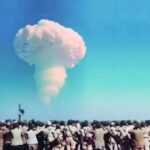The nonproliferation regime under siege
By Wolfgang K. H. Panofsky | August 5, 2007
Throughout the history of humanity, any new technology once invented and developed has diffused across the globe. Moreover, almost all new technologies have had dual use–that is, they could be used to improve the human condition, or they could be used to make the tools of violence even more destructive. We are now facing the inevitable sequel of this evolution as it relates to nuclear weapons. The world simply cannot afford to let nuclear weapons technology and acquisition diffuse all over the globe, considering the enormous destructive potential of even an individual nuclear explosive. So the historical tradition must be reversed, but how is this to be accomplished?
The Nuclear Non-Proliferation Treaty (NPT) bargain
Recognizing the necessity of stemming nuclear weapons proliferation, numerous discussions and initiatives took place during the 1950s and 1960s. A great impetus was given through President Dwight D. Eisenhower’s Atoms for Peace speech in 1953 in which he touted the benefits of nuclear power for peaceful goals, but expressed confidence that the military uses could be constrained.
Led by the United States, these discussions culminated in 1968, with the signing of the NPT. (The treaty came into force in 1970.) The NPT established a complex bargain between Nuclear Weapon States (NWS) and Non-nuclear Weapon States (NNWS), with those terms designating states who had tested or not tested nuclear weapons by 1968. Non-nuclear Weapons States were enjoined from acquiring nuclear weapons and Nuclear Weapons States were forbidden to transfer nuclear weapons and the wherewithal to make them to an NNWS. To compensate for this obvious discriminatory division of the world’s nations, NNWS were assured that they had an “inalienable right” to the peaceful application of nuclear energy, and the NWS obligated themselves in Article VI of the treaty to work in good faith toward nuclear disarmament.
The challenge of the NPT bargain
This bargain was reached after extensive debate and not unexpectedly, some weaknesses in the bargain have been evident since. The NWS were unwilling to accept a timetable for nuclear disarmament and the fuel cycle NNWS were allowed to undertake in pursuit of civilian nuclear power remained unrestricted. This latter failure weakens the NPT through an evident technical factor: enrichment of natural uranium to low-enriched uranium, the basic fuel for the vast majority of the world’s nuclear reactors today, and enrichment to highly enriched uranium approaching 90 percent in the isotope U-235, and is an essential ingredient for most nuclear weapons, require the same technology. At the same time, spent fuel contains varying amounts of plutonium generated by neutron capture in the original fresh fuel in the reactor. Separating this plutonium from spent fuel, or reprocessing, is not restricted by the NPT; as a consequence, both enrichment and reprocessing can be interpreted as part of the “inalienable right” to peaceful nuclear energy. But these processes clearly shorten the lead time for an NNWS to produce nuclear weapons once it decides to withdraw from the treaty or violate it.
To impede this diversionary process, the NPT requires each NNWS to negotiate an agreement with the International Atomic Energy Agency to provide for “safeguards,” that is, an inspection regime designed to prevent diversionary activities. The treaty provides that each party may withdraw after giving a six-month notice stating its reasons for withdrawal. Thus an NNWS can make preparations to commence a dedicated nuclear weapons program after having acquired the nuclear fuel cycle technologies (including reprocessing or enrichment) and then withdraw from the treaty.
The foregoing outlines the risk that some NNWS might prepare for “breakout” from the nonproliferation regime while still complying with NPT provisions. But no less important is the very real risk that the NWS may flaunt their nonproliferation obligations. The problem here is that the obligations undertaken by the NWS are not defined in quantitatively actionable terms.
Specifically, states (in particular, the United States and Russia) who have made substantial reductions in their enormous nuclear weapons stockpiles but still retain many thousands of nuclear weapons, can (and do) claim that they are in compliance with the NPT. But considering the continued enormous lethal holdings of nuclear weapons by the NWS, their pleas to the NNWS to forego weapons sound hypocritical, not unlike preaching abstinence while brandishing a glass of scotch.
How much nuclear weapons proliferation to date?
The United States detonated its first test weapon in Alamogordo, New Mexico, on July 16, 1945, and two bombs of yield about one-twentieth of the average explosive power of weapons in today’s stockpile killed 250,000 people in Hiroshima and Nagasaki. The Soviet Union broke the U.S. monopoly in 1949 through “Joe I,” its first nuclear test. Subsequently, seven other countries followed suit. At the same time, more than a dozen countries initiated but then terminated their nuclear weapons programs when they were persuaded that their security was better served without nuclear weapons.
Overall, the growth in nuclear weapons states has been much slower than most knowledgeable analysts predicted several decades ago. In view of this record, one should be loath to designate the NPT as a failure. On the contrary, the world is much better off in view of the NPT’s enactment.
The current threat
Notwithstanding the NPT regime’s successes, threats to its endurance are accumulating. Three countries (India, Pakistan, and Israel) remain outside the treaty, and North Korea withdrew from it after being accused of violations; currently, efforts are being made to woo North Korea back into the fold.
Iran has exploited the NPT’s weaknesses by invoking its “inalienable” right to pursue an enrichment program, and the Western powers suspect Iran of planning for nuclear weapons status. However, everyone should recognize that maintaining a future option for nuclear weapons acquisition and planning to do so are not the same thing. We also note that Brazil continues its enrichment program notwithstanding its ample supply of hydroelectric power. Japan has accumulated more than 40 tons of separated plutonium, one-tenth of which is located in Japan, with the rest in Europe. Thus, all these states might be considered “latent proliferators.”
In parallel with these developments relating to NNWS, NWS all claim to be proceeding toward nuclear disarmament; yet, all of them are operating programs that signal that they’re depending on nuclear weapons for their security for the indefinite future. Only China has officially declared a no-first-use policy, promising not to use nuclear weapons unless attacked with nuclear weapons first.
NPT signatories have agreed to convene Review Conferences of the working of the NPT every five years following preparatory meetings. It was during the 1995 Review Conference that the NPT was converted to a treaty of indefinite duration. However, the most recent Review Conferences have been acrimonious, exhibiting the sharp division between the NWS maintaining to be in full compliance with the NPT and the NNWS complaining about the treaty’s discriminatory aspects.
How to remedy threats to the nonproliferation regime
No single “silver bullet” exists that can remove the inherent tensions, contradictions, and risks of latent or outright violations inherent in the NPT regime. But much can and should be done to reduce the risks. The dominant need is to deemphasize the role of nuclear weapons in international security affairs. As the unquestioned leader in conventional armaments, the United States has most to gain by strengthening the NPT regime since it can deal with essentially all non-nuclear threats by non-nuclear means. Thus, the United States should convert its present ambiguous nuclear weapons policies to a simple doctrine that the only justifiable remaining mission of nuclear weapons is to deter the use of nuclear weapons by others. Under such a revised and narrow doctrine, the United States could drastically reduce its stockpiles beyond its present numbers and plans. This should form the basis of renewed vigor to negotiations with Russia to reduce its excessive nuclear forces, in particular the large number of tactical nuclear weapons, which constitute a proliferation threat on their own
Civilian nuclear power is justifiably slated for a major revival, together with its inherent proliferation risks. Despite the efforts to redesign the relevant technologies, there is no such thing as a “proliferation-proof” nuclear fuel cycle. The various approaches only differ by the level of safeguarding required to prevent diversion. The important element should be transparency. Beyond that, the only possible remedy is to internationalize the enrichment and reprocessing components of the nuclear field cycle by having those elements under ownership and control of an international agency that would guarantee an assured supply of low enriched fuel to all states while providing for safeguards of the nuclear facilities. Selective enforcement arrangements among “coalitions of the willing” to restrict transfer of nuclear materials will only perpetuate the discriminatory pattern.
But above all, in the long run, proliferation can be stopped only if motivation to nuclear proliferation can be curtailed through an increasing emphasis on diplomatic solutions to resolve conflict and a de-emphasis on violence–in particular, violence using nuclear weapons.
Together, we make the world safer.
The Bulletin elevates expert voices above the noise. But as an independent nonprofit organization, our operations depend on the support of readers like you. Help us continue to deliver quality journalism that holds leaders accountable. Your support of our work at any level is important. In return, we promise our coverage will be understandable, influential, vigilant, solution-oriented, and fair-minded. Together we can make a difference.
Topics: Nuclear Weapons, Opinion















